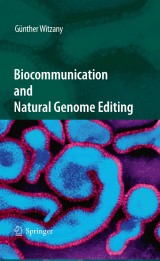Details

Biocommunication and Natural Genome Editing
|
CHF 177.00 |
|
| Verlag: | Springer |
| Format: | |
| Veröffentl.: | 20.10.2009 |
| ISBN/EAN: | 9789048133192 |
| Sprache: | englisch |
| Anzahl Seiten: | 213 |
Dieses eBook enthält ein Wasserzeichen.
Beschreibungen
I wrote this book for biologists and those who are interested in both biological affairs in general and perspectives which integrate a large number of specialised biological disciplines. The theory of biocommunication presented herein investigates signal transd- tion processes among cells, tissues, organs and organisms in bacteria, animals (corals and bees), fungi and plants in the light of the current available empirical data. Because life is the central focus of the life sciences, this theory will also focus on typical features of life as opposed to inorganic matter. Because this eld of investigation is based on the methodological primacy of a pragmatic action theory, the book may also be of interest to researchers of lingu- tics, communication sciences and sociology (e.g. plant sociology, animal sociology) who would welcome an overview of these highly specialised biological disciplines. Current molecular biology as well as cell biology investigates its scienti c object by using key terms such as genetic code, code without commas, misre- ing of the genetic code, coding, open reading frame, genetic storage medium DNA, genetic information, genetic alphabet, genetic expression, messenger RNA, ce- to-cell communication, immune response, transcription, translation, nucleic acid language, amino acid language, recognition sequences, recognition sites, protein coding sequences, repeat sequences, signalling, signal transduction, signalling codes, signalling pathways, etc.
Introduction: Metaphysical and Postmetaphysical Relationships of Humans with Nature and Life.- Plant Communication.- Communicative Competences of Honey-Bees.- Biocommunication of Corals.- Biocommunication of Fungal Organisms.- Bacteria Communication.- Natural Genome Editing Competences of Viruses and Virus-Like Agents.- How Bacteria Escaped Selection Pressure of the Early RNA-World.- Viral Origins of Telomeres and Telomerases.- Real Life-World of Noncoding RNA-Species.- Outlook.
<P>This is the first uniform description of all key levels of communication in the organismic kingdoms of plants, fungi, animals and bacteria based on the most recent empirical data. Biocommunication occurs on three levels (A) intraorganismic, i.e. intra- and intercellular, (B) interorganismic, between the same or related species and (C) transorganismic, between organisms which are not related. The biocommunicative approach demonstrates both that cells, tissues, organs and organisms coordinate and organize by communication processes and genetic nucleotide sequence order in cellular and non-cellular genomes is structured language-like, i.e. follow combinatorial (syntactic), context-sensitive (pragmatic) and content-specific (semantic) rules. Without sign-mediated interactions no vital functions within and between organisms can be coordinated. Exactly this feature is absent in non-living matter.</P>
<P>Additionally the biocommunicative approach investigates natural genome editing competences of viruses. Natural genome editing from a biocommunicative perspective is competent agent-driven generation and integration of meaningful nucleotide sequences into pre-existing genomic content arrangements and the ability to (re)combine and (re)regulate them according to context-dependent (i.e. adaptational) purposes of the host organism. The biocommunicative approach is an original scientific field of investigations. Readers must be competent in basic knowledge of biology and genetics.</P>
<P>Additionally the biocommunicative approach investigates natural genome editing competences of viruses. Natural genome editing from a biocommunicative perspective is competent agent-driven generation and integration of meaningful nucleotide sequences into pre-existing genomic content arrangements and the ability to (re)combine and (re)regulate them according to context-dependent (i.e. adaptational) purposes of the host organism. The biocommunicative approach is an original scientific field of investigations. Readers must be competent in basic knowledge of biology and genetics.</P>
First uniform description of all key levels of communication in the organismic kingdoms of plants, fungi, animals (bees and corals), bacteria and additionally the natural genome editing competences of viruses based on the most recent empirical data The biocommunicative approach presented is based on the results of the philosophy of science discourse concerning coherent definitions of 'language' and 'communication'
Diese Produkte könnten Sie auch interessieren:

Bioinformatics and Computational Biology Solutions Using R and Bioconductor

von: Robert Gentleman, Vincent Carey, Wolfgang Huber, Rafael Irizarry, Sandrine Dudoit

CHF 260.00

Chemical Signals in Vertebrates 11

von: Jane Hurst, Robert J. Beynon, S. Craig Roberts, Tristram Wyatt

CHF 271.50














